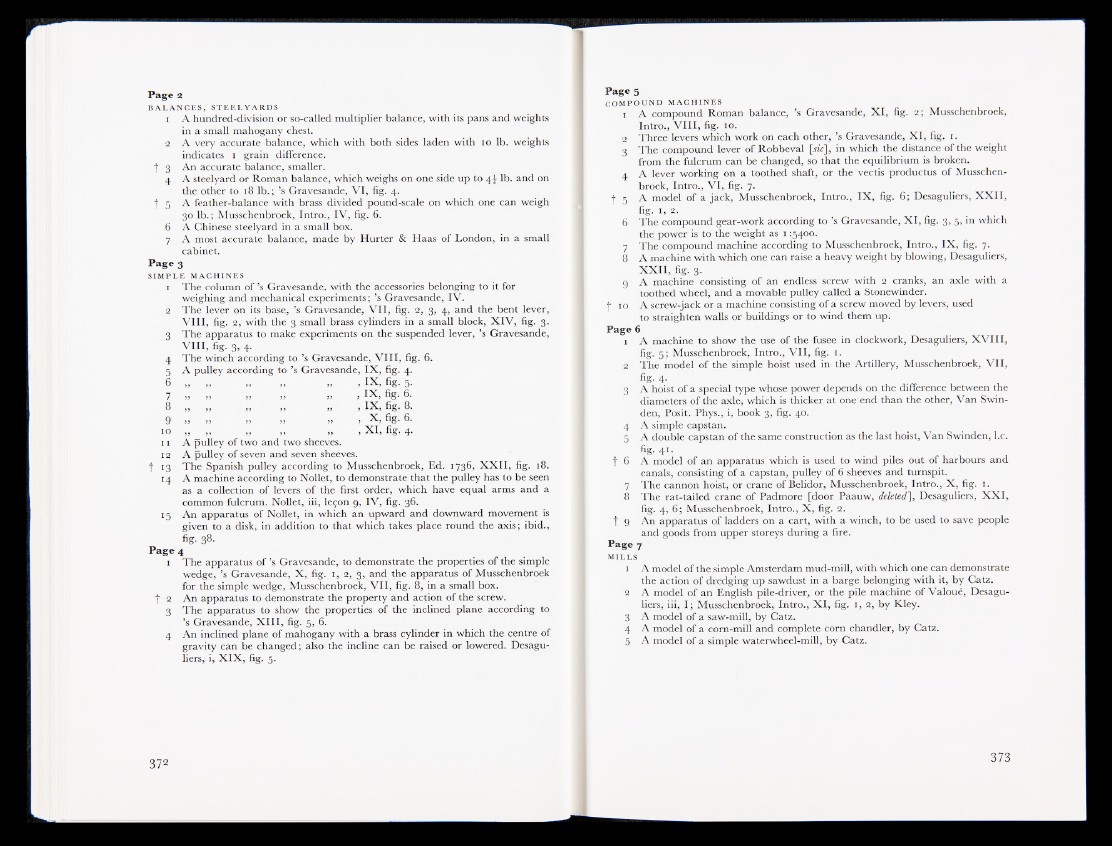
Page a
B A L A N C E S , S T E E L Y A R D S
1 A hundred-division or so-called multiplier balance, with its pans and weights
in a small mahogany chest.
2 A very accurate balance, which with both sides laden with io lb. weights
indicates i grain difference.
•f 3 An accurate balance, smaller.
4 A steelyard or Roman balance, which weighs on one side up to 4^ lb. and on
the other to 18 lb.; ’s Gravesande, VI, fig. 4.
f 5 A feather-balance with brass divided pound-scale on which one can weigh
30 lb.; Musschenbroek, Intro., IV, fig. 6.
6 A Chinese steelyard in a small box.
7 A most accurate balance, made by Hurter & Haas of London, in a small
cabinet.
Page 3
S IM P L E M A C H I N E S
1 The column o f ’s Gravesande, with the accessories belonging to it for
weighing and mechanical experiments; ’s Gravesande, IV.
2 The lever on its base, ’s Gravesande, VII, fig. 2, 3, 4, and the bent lever,
VIII, fig. 2, with the 3 small brass cylinders in a small block, XIV, fig. 3.
3 The apparatus to make experiments on the suspended lever, ’s Gravesande,
VIII, fig. 3, 4.
4 The winch according t o ’s Gravesande, VIII, fig. 6.
5 A pulley according t o ’s Gravesande, IX, fig. 4.
6 „ „ » » » = IX> %• 5-
7 „ „ „ » » , IX, fig. 6.
8 „ „ „ „ „ , IX, fig. 8.
9 „ ,, ,, „ „ j X, fig. 6.
to „ _ „ „ „ „ , XI, fig. 4.
11 A pulley of two and two sheeves.
12 A pulley of seven and seven sheeves.
f 13 The Spanish pulley according to Musschenbroek, Ed. 17363 XXII, fig. 18.
14 A machine according to Nollet, to demonstrate that the pulley has to be seen
as a collection of levers of the first order, which have equal arms and a
common fulcrum. Nollet, iii, leçon 9, IV, fig. 36.
15 An apparatus of Nollet, in which an upward and downward movement 3
eiven to a disk, in addition to that which takes place round the axis; ibid.,
■
Page 4
1 The apparatus o f ’s Gravesande, to demonstrate the properties of the simple
wedge, ’s Gravesande, X, fig. 1, 2, 3, and the apparatus of Musschenbroek
for the simple wedge, Musschenbroek, VII, fig. 8, in a small box.
I 2 An apparatus to demonstrate the property and action of the screw.
3 The apparatus to show the properties of the inclined plane according to
’s Gravesande, XIII, fig. 5, 6.
4 An inclined plane of mahogany with a brass cylinder in which the centre of
gravity can be changed; also the incline can be raised or lowered. Desagu-
liers, i, XIX, fig. 5.
Page 5
C O M P O U N D M A C H I N E S
1 A compound Roman balance, ’s Gravesande, XI, fig. 2; Musschenbroek,
Intro., VIII, fig. 10.
2 Three levers which work on each other, ’s Gravesande, XI, fig. 1.
3 The compound lever of Robbeval [sic], in which the distance of the weight
from the fulcrum can be changed, so that the equilibrium is broken.
4 A lever working on a toothed shaft, or the vectis productus of Musschenbroek,
Intro., VI, fig. 7.
t 5 A model of a jack, Musschenbroek, Intro., IX, fig. 6; Desaguliers, XXII,
fig. 1, 2.
6 The compound gear-work according t o ’s Gravesande, XI, fig. 3, 5, in which
the power is to the weight as 1 :5400.
7 The compound machine according to Musschenbroek, Intro., IX, fig. 7.
8 A machine with which one can raise a heavy weight by blowing, Desaguliers,
XXII, fig. 3.
9 A machine consisting of an endless screw with 2 cranks, an axle with a
toothed wheel, and a movable pulley called a Stonewinder.
| 10 A screw-jack or a machine consisting of a screw moved by levers, used
to straighten walls or buildings or to wind them up.
Page 6
1 A machine to show the use of the fusee in clockwork, Desaguliers, XVIII,
fig. 5; Musschenbroek, Intro., VII, fig. 1.
2 The model of the simple hoist used in the Artillery, Musschenbroek, VII,
fig. 4.
3 A hoist of a special type whose power depends on the difference between the
diameters of the axle, which is thicker at one end than the other, Van Swin-
den, Posit. Phys., i, book 3, fig. 40.
4 A simple capstan.
5 A double capstan of the same construction as the last hoist, Van Swinden, l.c.
fig. 41.
t 6 A model of an apparatus which is used to wind piles out of harbours and
canals, consisting of a capstan, pulley of 6 sheeves and turnspit.
7 The cannon hoist, or crane of Belidor, Musschenbroek, Intro., X, fig. 1.
8 The rat-tailed crane of Padmore [door Paauw, deleted], Desaguliers, XXI,
fig. 4, 6; Musschenbroek, Intro., X, fig. 2.
t 9 An apparatus of ladders on a cart, with a winch, to be used to save people
and goods from upper storeys during a fire.
Page 7
M I L L S
1 A model of the simple Amsterdam mud-mill, with which one can demonstrate
the action of dredging up sawdust in a barge belonging with it, by Catz.
2 A model of an English pile-driver, or the pile machine of Valou6, Desaguliers,
iii, I; Musschenbroek, Intro., XI, fig. 1, 2, by Kley.
3 A model of a saw-mill, by Catz.
4 A model of a corn-mill and complete corn chandler, by Catz.
5 A model of a simple waterwheel-mill, by Catz.